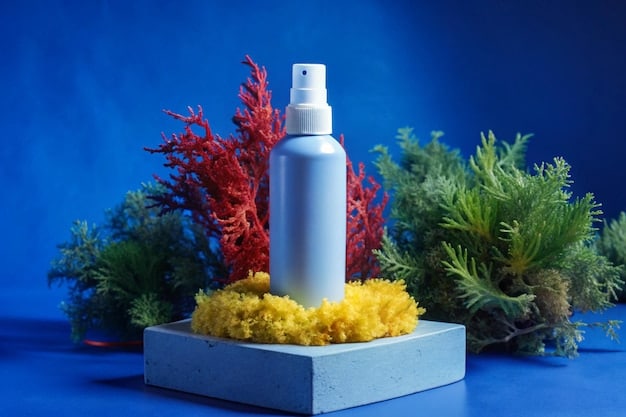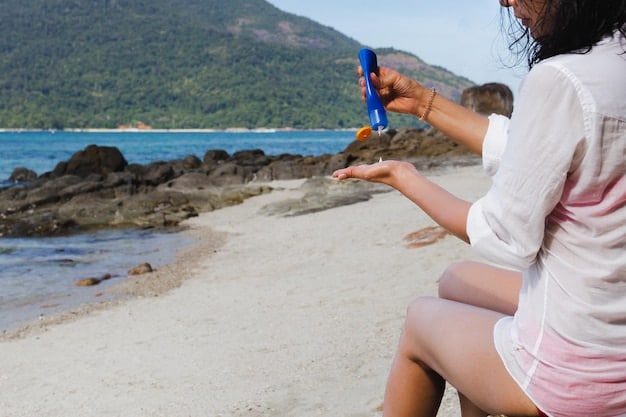Reef-Safe Sunscreen: A US Traveler’s Guide to Protecting Coral Reefs

Is Your Sunscreen Harming Coral Reefs? A Guide to Reef-Safe Options for US Travelers explores the environmental impact of common sunscreen ingredients on coral reefs, providing US travelers with information on how to choose reef-safe sunscreens and protect these vital ecosystems.
Heading to the beach? While protecting your skin from the sun is crucial, it’s equally important to consider the impact your sunscreen has on marine life. This guide, Is Your Sunscreen Harming Coral Reefs? A Guide to Reef-Safe Options for US Travelers, will help you make informed choices to protect both your skin and our planet’s precious coral reefs.
Understanding the Threat: How Sunscreen Harms Coral Reefs
Many conventional sunscreens contain chemicals that are toxic to coral reefs. These chemicals, washed off swimmers’ skin, accumulate in the water and disrupt the delicate balance of the reef ecosystem.
Oxybenzone and octinoxate are two of the most harmful ingredients. These chemicals can:
- Damage coral DNA, leading to deformities and reproductive issues.
- Disrupt the coral’s endocrine system, interfering with growth and development.
- Cause coral bleaching, weakening the coral and making it more susceptible to disease.
- Reduce coral’s resilience to climate change and other environmental stressors.
The impact of these chemicals is significant. Studies have shown that even small concentrations of oxybenzone can have devastating effects on coral reefs, leading to their decline and eventual death. With coral reefs providing habitat for a quarter of all marine life and supporting countless coastal communities, their destruction has far-reaching consequences.

Identifying Harmful Ingredients in Sunscreen
Knowing which ingredients to avoid is the first step in choosing a reef-safe sunscreen. It’s important to carefully read the labels and understand what you’re putting on your skin.
Common Culprits to Avoid
- Oxybenzone: A UV-filtering chemical that’s particularly toxic to coral.
- Octinoxate: Another common UV filter with harmful effects on coral.
- Octocrylene: Although less studied than oxybenzone and octinoxate, concerns are rising about its potential impact.
- Homosalate: A chemical UV filter that can disrupt hormones and accumulate in the environment.
- Avobenzone: While less directly toxic to coral, it can break down into harmful byproducts. When combined with octinoxate is particularly damaging.
- Parabens: Preservatives that can disrupt hormones and harm marine life.
- Microplastics: Tiny plastic particles that pollute the ocean and can be ingested by marine animals.
Decoding the Label: What to Look For
Unfortunately, sunscreen labels can be confusing. Look for terms like “non-nano” zinc oxide and titanium dioxide, which indicate mineral-based sunscreens. Avoid products with long lists of chemical ingredients. A shorter ingredients list is usually a good sign.
Remember, marketing terms can be misleading. Don’t assume a sunscreen is reef-safe just because it’s labeled as “eco-friendly” or “natural.” Always check the ingredients list.
By educating yourself about harmful ingredients and carefully reading sunscreen labels, you can make informed choices that protect both your skin and the environment. Every conscious decision helps to safeguard our coral reefs for future generations.
Reef-Safe Sunscreen Options for US Travelers
Fortunately, there are many reef-safe sunscreen options available that provide effective sun protection without harming coral reefs. These sunscreens typically use mineral-based ingredients like zinc oxide and titanium dioxide.
Mineral vs. Chemical Sunscreens: What’s the Difference?
The key difference is in how they protect your skin. Chemical sunscreens absorb UV rays, while mineral sunscreens create a physical barrier on your skin that reflects UV rays. Mineral sunscreens are generally considered safer for both humans and the environment.
- Mineral Sunscreens: Use zinc oxide and titanium dioxide to create a physical barrier against UV rays.
- Chemical Sunscreens: Absorb UV rays using chemicals like oxybenzone and octinoxate.
Mineral sunscreens are also often less irritating for sensitive skin.
Recommended Reef-Safe Sunscreen Brands
Many brands are now dedicated to producing reef-safe sunscreens. Some popular options include:
- Raw Elements: Known for its zinc-based sunscreens and plastic-free packaging.
- Badger Balm: Offers a range of organic and reef-safe sunscreens.
- Thinksport: Creates high-performance mineral sunscreens for athletes and active individuals.
- Stream2Sea: Formulated specifically to be safe for aquatic life.
- All Good: Provides a variety of reef-friendly sunscreens, including tinted options.
When choosing a reef-safe sunscreen, look for products that are:
- Non-nano zinc oxide or titanium dioxide based
- Free of oxybenzone and octinoxate
- Water-resistant
- Broad spectrum (protects against UVA and UVB rays)
Remember to apply sunscreen liberally and reapply every two hours, or more often if swimming or sweating. By choosing reef-safe sunscreens, you can enjoy the sun and protect our oceans at the same time.
Beyond Sunscreen: Responsible Beach Practices
Choosing reef-safe sunscreen is a great start, but there are other ways to minimize your impact on the marine environment during your beach vacation. Responsible beach practices can go a long way in protecting coral reefs and other coastal ecosystems.

Reducing Your Environmental Footprint
- Avoid single-use plastics: Bring your own reusable water bottle, shopping bag, and food containers.
- Properly dispose of trash: Never leave any trash on the beach or in the water.
- Respect wildlife: Observe marine animals from a distance and avoid touching or feeding them.
- Support sustainable tourism: Choose tour operators and businesses that prioritize environmental conservation.
Supporting Local Conservation Efforts
Many organizations are working to protect coral reefs and other marine ecosystems. Consider supporting these efforts by:
- Volunteering your time: Participate in beach cleanups or coral reef restoration projects.
- Donating to conservation organizations: Support the work of groups dedicated to protecting marine environments.
- Educating others: Share your knowledge about reef-safe sunscreen and responsible beach practices with your friends and family.
Advocating for Change
You can also make a difference by advocating for policies that protect coral reefs, such as:
- Supporting bans on harmful sunscreen ingredients: Encourage your local and state governments to ban the sale of sunscreens containing oxybenzone and octinoxate.
- Promoting sustainable tourism practices: Advocate for policies that encourage responsible tourism and environmental conservation.
- Raising awareness about climate change: Support efforts to reduce greenhouse gas emissions and mitigate the effects of climate change on coral reefs.
Legislative Action: Sunscreen Bans in the US and Beyond
Growing awareness of the damaging effects of chemical sunscreens has led to legislative action in various parts of the world. Bans on sunscreens containing oxybenzone and octinoxate are becoming increasingly common, aiming to protect vulnerable coral reef ecosystems.
Where Are Sunscreen Bans in Place?
Several locations have already implemented sunscreen bans. These include:
- Hawaii: In 2018, Hawaii passed a law banning the sale and distribution of sunscreens containing oxybenzone and octinoxate, which went into effect in 2021.
- Key West, Florida: Similar to Hawaii, Key West banned these chemicals in 2021.
- Republic of Palau: Implemented a comprehensive ban on sunscreens containing 10 harmful chemicals in 2020.
- U.S. Virgin Islands: Banned oxybenzone, octinoxate, and octocrylene in 2020.
- Aruba: Prohibited the sale of sunscreens containing oxybenzone in 2020.
- Bonaire: Introduced a ban on oxybenzone and octinoxate in 2021.
These bans reflect a growing recognition of the need to protect coral reefs from the harmful effects of chemical sunscreens. By restricting the sale and use of these products, these locations are taking a proactive step towards preserving their marine ecosystems.
The Impact of Sunscreen Bans
The effectiveness of sunscreen bans in protecting coral reefs is still being studied. However, early evidence suggests that these bans can have a positive impact.
- Reduced chemical concentrations: Banning harmful chemicals can lead to a decrease in their concentrations in the water, reducing the exposure of coral reefs to these toxins.
- Increased awareness: Sunscreen bans can raise awareness among tourists and residents about the importance of choosing reef-safe products.
- Support for reef-safe alternatives: Bans can encourage the development and use of reef-safe sunscreen alternatives, further reducing the impact on coral reefs.
While sunscreen bans are not a silver bullet, they are an important tool in the fight to protect coral reefs. By combining bans with other conservation efforts, such as reducing pollution and mitigating climate change, we can give coral reefs a better chance of survival.
By staying informed about legislative actions and supporting sunscreen bans, you can contribute to the protection of coral reefs around the world.
Planning Your Trip: Finding Reef-Friendly Destinations
When planning your next beach vacation, consider choosing destinations that prioritize coral reef conservation. These destinations often have regulations in place to protect their marine ecosystems, including restrictions on harmful sunscreens and sustainable tourism practices.
Top US Destinations for Reef-Friendly Travel
While reefs in Florida and Hawaii are most popular, they are also the most at risk. Consider these vacation spots instead:
- Dry Tortugas National Park, Florida: Known for its pristine coral reefs and abundant marine life, Dry Tortugas National Park offers excellent snorkeling and diving opportunities.
- Channel Islands National Park, California: These islands boast kelp forests and diverse marine ecosystems with unique species of fish.
Tips for Planning a Sustainable Trip
- Do your research and choose accommodations and tour operators that prioritize sustainability.
- Pack reef-safe sunscreen, reusable water bottles, and other eco-friendly essentials.
- Support local businesses and conservation initiatives.
- Respect local regulations and guidelines for protecting marine environments.
By choosing reef-friendly destinations and following sustainable travel practices, you can enjoy a memorable vacation while contributing to the protection of our planet’s precious coral reefs. Remember, every conscious decision makes a difference.
| Key Takeaway | Brief Description |
|---|---|
| ⚠️ Harmful Ingredients | Avoid oxybenzone, octinoxate, and other chemicals that damage coral reefs. |
| ✅ Choose Mineral Sunscreen | Opt for non-nano zinc oxide or titanium dioxide sunscreens. |
| 🏖️ Beach Practices | Reduce your plastic use, dispose of trash properly, and respect wildlife. |
| 🌎 Support Conservation | Advocate for sunscreen bans and support sustainable tourism. |
Frequently Asked Questions (FAQ)
▼
A reef-safe sunscreen lacks harmful chemicals like oxybenzone and octinoxate, which damage coral DNA and disrupt their growth. Mineral-based options with zinc oxide and titanium dioxide are preferred.
▼
Yes! Reef-safe mineral sunscreens provide broad-spectrum protection against UVA and UVB rays when applied correctly. Reapply every two hours or after swimming/sweating for best results.
▼
Non-nano particles mean the mineral particles are large enough not to be ingested by coral or other marine life. This reduces the environmental impact of the sunscreen.
▼
Even without swimming, sunscreen chemicals can wash off into waterways via showering or handwashing. It’s best to consistently use reef-safe sunscreen everywhere, not just at the beach.
▼
Reef-safe sunscreens are increasingly available at drugstores, supermarkets, and online retailers. Look for the ingredients mentioned above and check labels carefully to make the right choice.
Conclusion
Protecting our coral reefs is a shared responsibility. Choosing reef-safe sunscreen, adopting responsible beach practices, and supporting conservation efforts are simple yet impactful steps that US travelers can take to make a difference. Together, we can preserve these vital ecosystems for future generations to enjoy.





